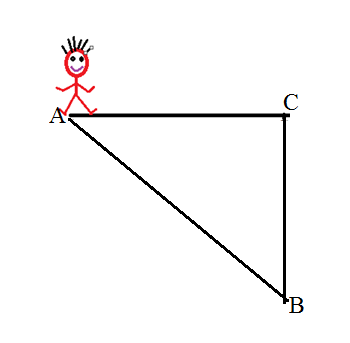
Concept explainers
To Find: Magnitude of the displacement is less than or more than the distance travelled.
Answer to Problem 1P
Magnitude of the displacement is always less than or equals to the distance travelled.
Explanation of Solution
Introduction:
Distance can be defined as the total path length travelled by a body. Its S.I. unit is
Where,
Displacement can be defined as the path difference between the initial and final position of the body. It is the minimum distance between two points.
Its S.I. unit is
Here are some examples,

Consider a body is travelling along a straight line from A to B and then B to C.
Total distance travelled by the body
Displacement of the body
Consider a body is moving in a circular path of radius
Since,
Therefore, distance travelled > displacement

Total distance traveled by the body = circumference of the circle
Displacement of the body = final position − initial position.
Here body come to its initial position after revolution
Therefore,
final position = initial position
hence,
Displacement of the body
Again, distance > displacement

Consider a body travelling in a straight line from A to B
Distance travelled = AB
Displacement = AB
Here, Displacement = Distance travelled
Conclusion:
Displacement of a body can never be greater than the distance travelled by the body. It is either equal to the distance travelled by the body or less than it.
Want to see more full solutions like this?
Chapter 3 Solutions
Physics for Scientists and Engineers
- Under what circumstances does distance traveled equal magnitude of displacement? What is the only case in which magnitude of displacement and displacement are exactly the same?arrow_forwardIs it possible for two vectors of different magnitudes to add to zero? Is it possible for three vectors of different magnitudes to add to zero? Explain.arrow_forwardRaindrops hitting the side windows of a car in motion often leave diagonal streaks even if there is no wind. Why? Is the explanation the same or different for diagonal streaks on windshield? Explain in 10 sentencesarrow_forward
- The magnitude of the normal acceleration component is determined from:arrow_forwardCan an object have a varying speed if its velocity is constant? Can it have varying velocity if its speed is constant? If yes, give examples in each case.arrow_forwardSpeed is the magnitude of the velocity. When we say speed is constant, we mean that the magnitude of the velocity is constant. If the speed of a particle is constant can we say that it doesn't experience any acceleration?arrow_forward
- Can the magnitude of a particle’s displacement be greater that the distance traveled?arrow_forwardYou take your dog on a walk to a nearby park. On the way, yourdog takes many short side trips to chase squirrels, examine fire hydrants, and so on. When you arrive at the park, do you and yourdog have the same displacement from home? Have you and yourdog traveled the same distance? Explainarrow_forwardHow could two moving objects travel different distances, but have the same displacement?arrow_forward
- During baseball practice, a player hits a very high fly ball and then runs in a straight line and catches it. Which had the greater displacement, the player or the ball? Explain.arrow_forwardA cross-country skier skis 1.0 km north and then 2.0 km east. How far and in what direction is she from the starting point? What are the magnitude and direction of her resultant displacement? (Complete solution)arrow_forwardThe acceleration of a particle moving along a straight line is a = (11 - 1.0s) m/s², where s is in meters. If v = 0 when s = 0, determine the magnitude of the particle's velocity when s = 7.0 m.arrow_forward
 Principles of Physics: A Calculus-Based TextPhysicsISBN:9781133104261Author:Raymond A. Serway, John W. JewettPublisher:Cengage Learning
Principles of Physics: A Calculus-Based TextPhysicsISBN:9781133104261Author:Raymond A. Serway, John W. JewettPublisher:Cengage Learning University Physics Volume 1PhysicsISBN:9781938168277Author:William Moebs, Samuel J. Ling, Jeff SannyPublisher:OpenStax - Rice University
University Physics Volume 1PhysicsISBN:9781938168277Author:William Moebs, Samuel J. Ling, Jeff SannyPublisher:OpenStax - Rice University

